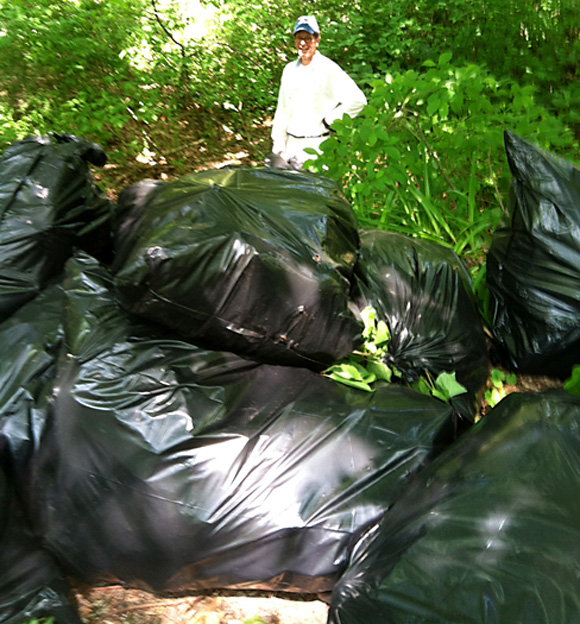Progress on many fronts in Mill River Knotweed removal
One of our high-priority goals this year is to take steps to remove invasive Japanese Knotweed where it’s growing along the Mill River so indigenous plants will again line the banks and restore the natural balance of flora and fauna for a healthy stream. We’ve begun with the section flowing along Congress Street in Fairfield because of its concentration of this invasive. Here’s what we’ve done so far:
• Cut down Knotweed in the biggest growths along the Fairfield side (between the river and Congress St.) from Route 59 downstream (west) to the Congress St. bridge over the river. We have significantly weakened all these growths so their rhizomes and shoots will be more susceptible to controlled herbicide spraying this Fall.
• Intentionally left selected growths standing as control plots for the upcoming herbicide spraying. This will help us determine the extent cutting is needed going forward vs. spraying only, in our multi-year plan for eradication.
• Won approval from all(!) eight Easton homeowners on the north bank to help them eradicate knotweed on their properties and cut down the major knotweed growths there. This paves the way for our future collaboration on additional key restoration steps such as improving in-stream structure and sinuosity.
• Cut down knotweed on the Covenant Church Easton property, having won their support for our efforts.
• Built/strengthened partnerships with the Fairfield Conservation Department and Easton Conservation Commission to pursue Knotweed eradication (and other restoration steps) along the Mill.
• Worked with these departments, the Aspetuck Land Trust and DEEP to determine the best multi-step approach to Knotweed eradication, involving biologically safe herbicide treatment this coming Fall.
• Begun a plan for free other sections of the Mill from Knotweed incursion, and from other invasive species, building on the work Ross Ogden led for us with the ALT.
So we’ve done a lot with solid results so far, and with more to come! We hope you’ll drive along Congress Street to see how the Knotweed there is weakened and picture how this section of the Mill will look when native plants once again are the only species growing there!

Great work on he knotweed removal effort. It would be helpful if in addition to showing what is removed to also include a close-up of the plants (not just knotweed) being removed. This would allow removal of the plant if identified on other waters to be removed. Thank you
Great idea George. At the moment we’re focusing solely on knotweed at the request of the Town of Fairfield. This link, posted at the start of the project, has more detailed images and information regarding knotweed. https://www.nutmegtrout.org/wp-content/uploads/2013/05/WS_4_POLCU_042707japaneseknotweed.pdf
I looked using Goggle “image” search and found this above website where they not only have photo’s, but also let it be know that in fact it is edilbe! Check out the link below.
http://tinyurl.com/kjmoxrw